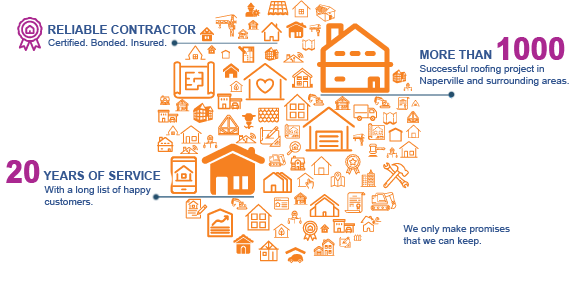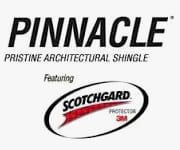Cedar Shingle Roof vs. Asphalt Shingle Roof: Which Is The Right Roofing Material For Your House?
Cedar and asphalt shingled roofs are the predominant materials used across the United States. While other material types, like metal, slate and ceramic tile roofing are options, they pale in comparison to the popularity of cedar and asphalt. If you’re considering a roofing project, you’re likely questioning which would be the preferable material for your home. That’s what we will discuss thoroughly here.
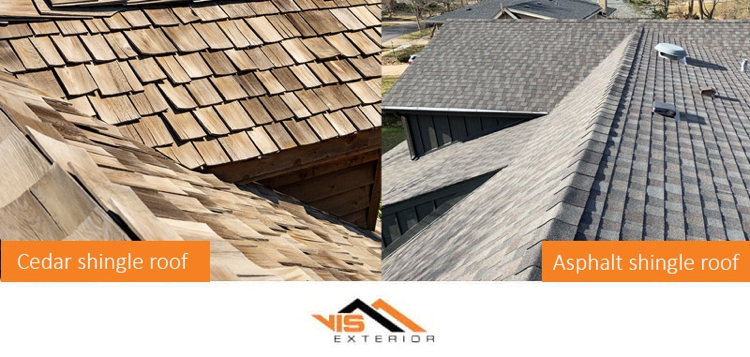
As Chicagoland’s go-to roofing contractor, we’ve installed cedar and asphalt shingles on many, many homes. We have established a reputation for our customer-centric services and our attention to the finest details. Our roofers are top-notch professionals who respect every job site and leave it cleaner than what they found it.
If you’re embarking on a home improvement project and have questions about how to proceed with replacing your roof, you’ve come to the right place.
Table of contents:
- COMPARISON OF CEDAR & ASPHALT SHINGLE ROOFING

- CEDAR SHINGLE & SHAKE FOR ROOF REPLACEMENT

- ASPHALT SHINGLE FOR ROOF REPLACEMENT

- COMPARISON OF PROS AND CONS CEDAR & ASPHALT SHINGLE MATERIALS

- CEDAR ROOF VS. ASPHALT SHINGLE: WHICH IS BETTER?

- CHOOSING THE EXPERIENCED ROOF REPLACEMENT CONTRACTOR FOR THE JOB

Comparison of cedar & asphalt shingle roofing
Cedar and asphalt shingles are extremely popular material choices throughout the U.S. Each has their unique positive attributes and cap off a home with protective layers that also provide added curb appeal. It’s important to note here that you won’t see those positive attributes if you choose the wrong roofing contractor, so make sure you do your research and choose wisely.
The following are some of the most commonly cited descriptors of cedar shingles and asphalt shingles:
Cedar Shingles
- Gain on average around 10 more years with cedar than you’ll see with asphalt
- A natural insulator, cedar can help reduce your utility costs
- Cedar is a renewable resource, making it a more eco-friendly material
- Natural wood look is a highly sought-after material for those demanding a specific aesthetic and improved resale value
- From pests to wind to hail, cedar is more resilient than asphalt
- Cedar is more costly than asphalt
- More labor is involved with installing cedar, which will impact total costs
- When damages do occur, you’ll pay more to fix cedar than asphalt
- Be prepared to put more time into maintaining a cedar roof, which can be susceptible to mold, insects and fire when not properly treated and maintained
Asphalt Shingles
- Few materials are as easy to install and repair than asphalt
- The ease of installation makes asphalt a more cost effective material for the budget conscious
- Choose from a wide variety of colors and styles
- Low maintenance is one of the biggest asphalt perks
- Asphalt is more fire resistant than cedar
- Asphalt is less resilient than cedar where hail and high winds are concerned
- Asphalt will show signs of wear as it ages, including granule loss, dents, buckling and curling
- Among all the roofing materials, asphalt has the shortest lifespan
- Not considered eco-friendly, asphalt shingles are not recyclable
If you need assistance in figuring out which material will best suit your home, your tastes and your future needs, VIS Exterior can provide you with more detailed analysis of each material and help you make a fact-based decision that won’t have you second-guessing yourself.
Cedar shingle & shake for roof replacement
If you’re going for the unique aesthetic that only cedar can provide, either in its shingle or shake versions, no other material is going to live up to what cedar brings to the table. While the look is of utmost importance to many of our clients, there are other perks to choosing cedar. First and foremost is the fact that cedar is a natural insulator that can help you gain control of your energy costs.
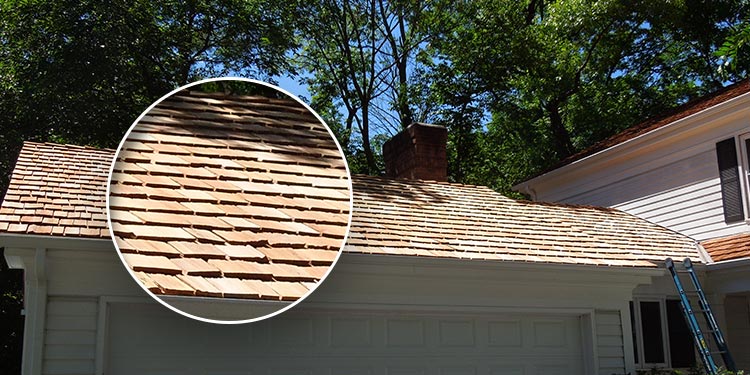
Cedar is also the choice among the eco-conscious because it is a green, recyclable material that can do the environment no harm. It lasts 30-plus years and is naturally pest resistant. It also ages interestingly, achieving various tones throughout the years that is welcomed by almost all property owners who have chosen this material. It’s these perks that bring value, which means when you spend more for this material than you will asphalt, the cost isn’t as big of an issue.
Asphalt shingle for roof replacement
Being on a budget isn’t the only reason homeowners choose asphalt shingles for their roofs. And while affordability is one of the top reasons asphalt shingles are the most popular roofing materials, they are also among the most versatile coming in many shapes, sizes and colors. Furthermore, the highest-quality asphalt shingles are so durable they can handle wind speeds up to 150 mph.
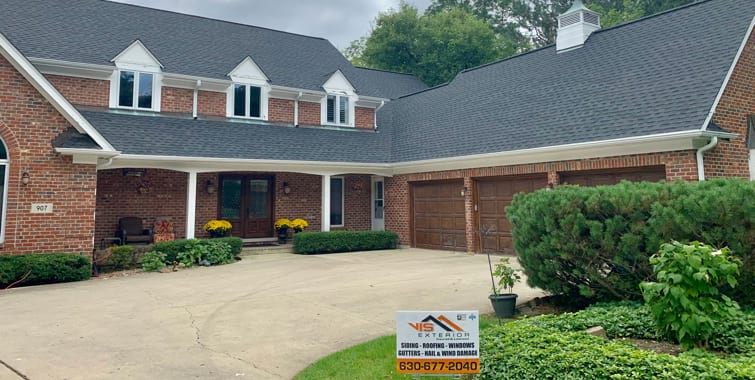
If you think it’s time to replace your asphalt roof, VIS Exterior will provide a thorough inspection of every component of the roofing system and determine if your roof has some years left in it, needs some routine maintenance/repairs or if it’s time for a complete replacement. Our knowledge of every aspect of the roof provides us with the insights needed to efficiently install the new roof, which will protect your home for at least 20-plus years and.
Comparison of pros and cons cedar & asphalt shingle materials
For those who are split on the decision between asphalt and cedar, making a list of the pros and cons can make it easier to decide. And there are many factors to consider, including appearance, cost, complexity of installation, energy efficiency and more.
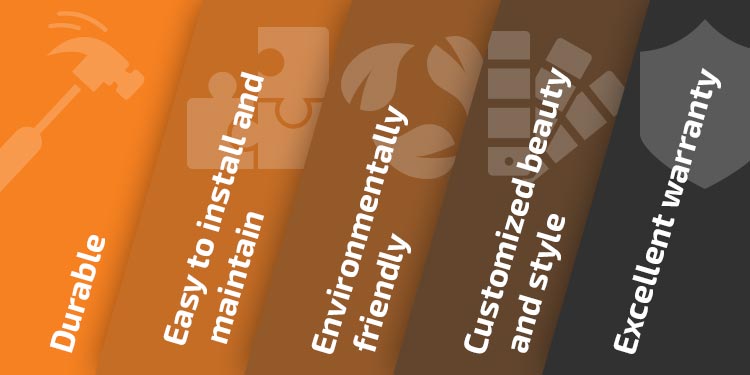
Cedar shingle & shake roof advantages
We’ve established that cedar is aesthetically appealing, but did you know that cedar is also among the more efficient materials in providing the type of air circulation that is important for any house? Homes have to breathe, otherwise moisture can collect in hidden areas and create an environment that leads to mold, mildew and rot.
Another “pro” with choosing cedar is that they are known to withstands all types of inclimate weather, such as hurricanes, thunderstorms, hail and other flying debris. The following is a list of some of the more commonly associated attributes cedar offers:
Cedar pros:
- Curb appeal: The rustic charm of cedar is immediately noticeable. Even as it weathers, it retains that charm and offers a look that says “I’m aging gracefully.”
- Lifespan: A properly cared for cedar shake roof can last a half century. Few other materials can boast such resiliency.
- Value added: A cedar roof is definitely a value-added material that homeowners know will help them sell when the time comes. First impressions go a long way, and when a potential home buyer sees your cedar roof, it might be the reason you get asking price.
- Eco-friendly: Consumers are increasingly wary of non-eco-friendly materials, which is why choosing natural wood makes sense today. Cedar is biodegradable/recyclable, which means it meets the sustainability standard many people hold today.
- Efficiency: Cedar is a known insulator capable of drastically reducing your energy costs. This means that over the years, the higher costs can be offset by lower utility bills.
There are so many pros to using cedar on your roof that it is easy to see why so many homeowners choose it. If you’re ready to take the next step, contact us at VIS Exterior and let’s talk about how we’ll install it on your home.
Asphalt shingle roof advantages
Not only is asphalt roofing material less costly to purchase than other materials, it is also easy to install, which means the estimate for labor will be lower. Another advantage with asphalt shingles is that producers offer it in so many shapes, colors and styles. If you want a more basic, plain look, they’ve got you covered. If you want a more complex three-dimensional appeal, that too is available.
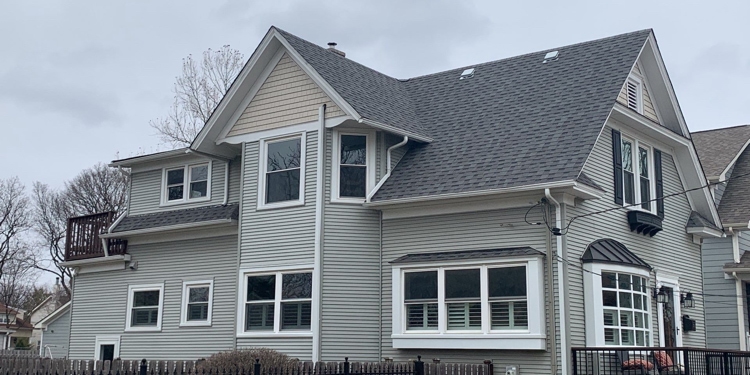
For homeowners looking for a highly fire resistant material, asphalt also offers that. Whether it’s fireworks that land on your rooftop or embers from a nearby fire, asphalt reduces the risk that the embers will lead to greater damage. And unlike cedar, asphalt roofs do not need to be treated, so they’re the low maintenance option.
Just take a look around your area and see all the different types of asphalt shingles that are available to you. If you want to know more about this type of roofing material, contact us at VIS Exterior and we can go into more detail about what is available to you.
Asphalt pros:
- Easy to install: Professional roofers will have your asphalt shingles, which are lightweight, installed on your home in a fast and efficient manner, which means you pay less in labor costs.
- Energy efficient: VIS Exterior works with asphalt shingle producers who meet the Energy Star standard, which means you are eligible for rebates. Plus, because they don’t absorb as much heat as other materials, your utility bill will be lower.
- Eco-friendly: While not as environmentally friendly as cedar, asphalt shingle producers have improved their methods to make their products less of a threat to the environment.
- Affordable: Nothing beats the price of asphalt shingles, which can be mass produced quite easily.
- Fire-resistant: Just about every component of asphalt shingles is fire resistant, so you don’t have to worry about your roof being the source of a house fire.
- Low-to-no maintenance: Should a storm rip through your area and damage some of your shingles, they are quite easy to replace.
- Long lifespan: Asphalt shingles from a reputable manufacturer that are installed correctly can last as long as 30 years.
- Many options: Asphalt shingle manufacturers have vastly expanded the colors, shapes and patterns of their products. Some even look like real wood. If you’ve got an idea for what you want your roof to look like, there is likely an asphalt shingle that will fit.
It’s difficult to argue against choosing asphalt shingles. There are clear advantages for everyone, including those who just want to save some money and those with a clear vision of what the aesthetic of their roof should be.
Cedar shingle & shake roof disadvantages
There are many great things to say about cedar roofs, but when it comes to wet climates, cedar isn’t always a good choice if longevity is what you’re looking for. The frequency of moisture will lead to mold or mildew, which can also lead to rot. And while the rot might be isolated to areas of the roof, cedar is difficult to replace. In fact, sometimes it’s easier/less costly to just replace the whole roof because they’re nailed down in such a way that extraction is a difficult task.
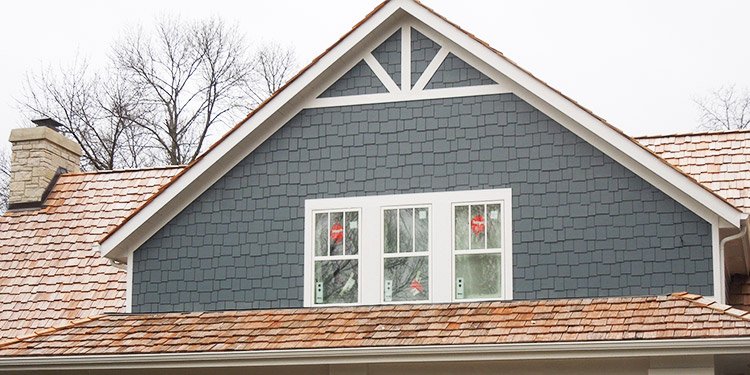
Another issue you’ll find with cedar is when you have plenty of shade trees around, even a normal amount of precipitation becomes an issue because the cedar doesn’t receive sufficient sunlight to completely evaporate the moisture, which leads to mildew and mold issues, which year after year will lead to rot. There is also the issue of fire. Cedar is more flammable than asphalt, so if the risk of fire is something that concerns you, choosing a material other than cedar would be in your best interests.
Finally, there is the cost issue. Cedar is among the more expensive roofing materials, which will instantly bump up your estimate. It’s also labor intensive to install, so you’ll have a higher labor cost when you choose cedar.
Cedar cons:
- Additional maintenance required: Annual maintenance is a must if you want to hit the 20-30 year lifespan of a cedar roof. This often involves mold and mildew remediation and protective coatings for pest resistance.
- Cost: The budget conscious rarely choose cedar when they have a choice to go with asphalt instead. Initial costs plus the cost of maintenance can be too much on the budget of many homeowners.
- Lifespan: Even with a perfect maintenance record, cedar shingles have a lifespan of 20 to 30 years.
- Installation complexities: Only choose the best roofing contractor with plenty of experience with this material to install your cedar roof. Otherwise, you’re likely to have issue after issue come up and you will regret having made this choice.
If cost and maintenance aren’t an issue for you, cedar might be the premium product for your home. Those who choose cedar should know what they’re getting into and choose the right contractor to install it.
Asphalt shingle roof disadvantages
One of the biggest complaints about asphalt shingles is that algae can under the right conditions, algae can proliferate on it, particularly on areas of the roof that receive an abundance of shade. When this happens the asphalt develops staining that lessens the appeal of the roof and can lead to structural issues allowing moisture to seep through the roof.
Should you experience a storm with high winds, asphalt shingles are more apt than cedar to blow off. Asphalt shingles can also take a beating during hailstorms, which either lead an erosion to the outer layers of the asphalt, which will shorten its lifespan, or to a need to completely replace the roof.
Asphalt shingle cons:
- Bad choice for flat surfaces: Flat roofs with asphalt shingles tend to wear out faster than other materials, mostly due to weathering.
- Susceptible to weather damage: When severe weather with particularly high winds sweep through your area, asphalt shingles often bear the brunt of the damage.
While nobody can control Mother Nature’s wrath, be mindful that when choosing asphalt shingles, as the risk for damage is always there. With proper maintenance and inspections, you can stay on top of the damages.
We will cover the following important topics about cedar and asphalt shingles:
The difference in physical appearance of wood & asphalt shingles
The production of asphalt shingles stands in stark contrast to how cedar shingles are made, therefore they have a completely different look. ASphalt shingles are layered together viea organic materials and fiberglass, whereas cedar comes from a tree.
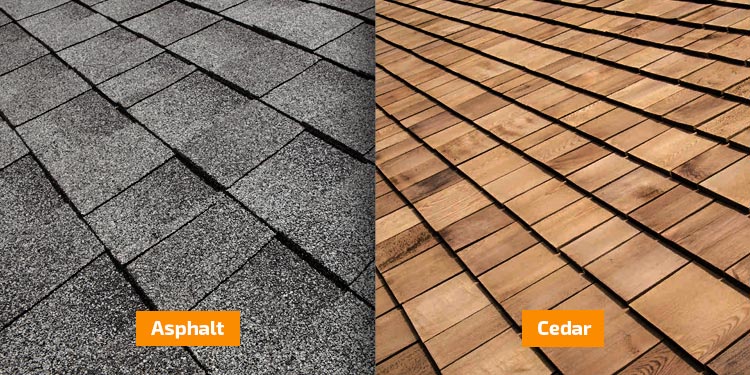
The interesting thing about wood is that no two trees are alike, which means the shingles will have subtle differences in appearance, thickness, etc. By contrast, asphalt shingles are known for their exacting consistency. Where cedar is rustic and organic, asphalt offers a cleaner and definitely more uniform aesthetic.
Appearance of cedar roofing
If you're going for that woodsy, classic look, you’ll get it with cedar shingles. Sourced from vast forests in the Pacific Northwest and white cedar from the Northeast U.S., cedar offers a very specific look that can be the focal point of a home or simply add to its overall curb appeal.
For hundreds of years, people have clad their roofs with cedar. For homeowners who want nothing to do with synthetic materials potentially clashing with the look of their structure, cedar is the go-to roofing material. From old stately homes to new modern designs, cedar can be a good fit.
Appearance of asphalt shingle roofing
Asphalt shingles have a history of putting homeowners in divided camps: one side finds them to be of value only in their function, while another side views asphalt shingles as the best choice for a home meeting contemporary standards.
When installed properly on a home in the right conditions (no constant shade or excessive moisture buildup) asphalt shingles will not age like cedar, which means they should look the same after a decade that they did upon installation. Furthermore, given the many options in color, size and style, homeowners have an abundance of appearance options with asphalt shingles.
Cedar vs asphalt – which lasts longer?
for most homeowners, longevity equals value. for those who are on the fence in the debate of cedar vs. asphalt, longevity can be the decision maker. however, it’s worth noting that according to the national association of realtors, since 2008 the average number of years a family will stay in the same household is only nine years. that means if you have your roof replaced during year one in your home, by the time you put it on the market it will still look great. the only caveats being that your cedar roof was treated and maintained over that time and your asphalt roof did not experience an abundance of heavy windstorms with debris.
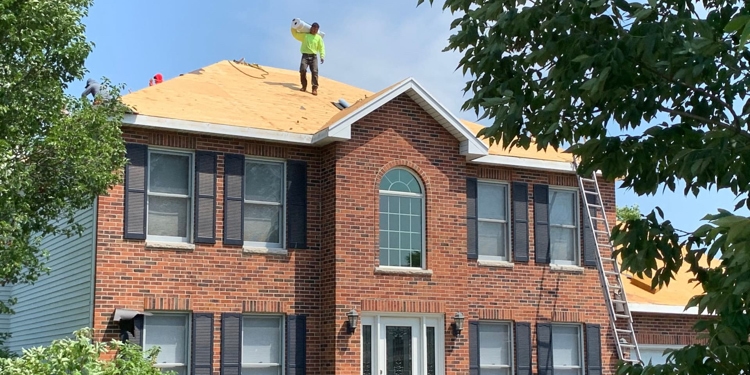
The lifespan of cedar shingles
Cedar shingles can last up to 30 years, perhaps longer in perfect conditions. However, the lifespan of cedar shingles is highly dependent on the homeowner doing their part in making sure the material is treated and mildew and mold aren’t allowed to build up. This can be accomplished by partnering with a roofing contractor who will make annual visits to ensure the quality of the material is maintained.
For homeowners who foresee themselves in the home for another 10 years and the roof is nearing the end of its lifespan, it’s not a bad idea to consider replacing it. They can enjoy the new look of the roof for their remaining time in the home and then reap the benefits of having a selling point to tout once they put the house on the market.
The lifespan of asphalt shingles
Most asphalt shingle manufacturers say their products will last around 20 years. The biggest threats to the lifespan of an asphalt roof is poor installation and inclement weather, especially hail. Careful inspection of the roofing system following big storms can reveal problem areas that can be relatively easily fixed by your roofing contract, which means you can avoid a costly and complete replacement.
If you plan on being in your home for three decades, which is roughly how long cedar will last, you might decide against having asphalt shingles installed. It’s prudent to think down the road and what will make the most financial sense for you. If cedar will last throughout your time in the home and well into the next resident’s time in it, it might be a better option than asphalt.
Comparing cedar and asphalt shingle roof’s long-term durability
While cedar is often associated with handling wind storms better than asphalt, both materials are considered by professional roofers to be “durable.” However, part of the reason cedar is believed to last longer than asphalt is because it actually is more durable than asphalt.
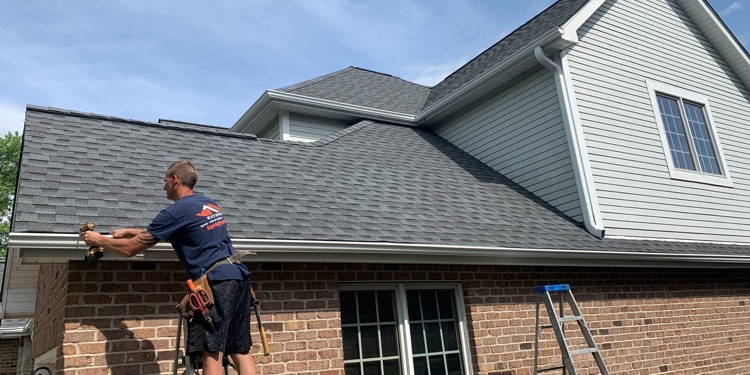
There will be risks involved with cedar in terms of durability in some very specific environments, such as those prone to fire and those prone to prolonged periods of precipitation. Conversely, asphalt is known for being extremely durable in wet climates, just as long as the rain doesn’t come with frequent high winds, because high winds and debris are Kryptonite to asphalt shingles.
The durability of cedar shingles
If you’re risk averse in regard to the elements, cedar is likely going to be the choice that you gravitate toward, because professional roofers have known for many, many years that when they complete a job installing cedar, it looks great year after year, even after punishing storms. Furthermore, cedar can be a great option for cold climates.
One aspect that will negatively impact the durability of cedar is that when moisture is allowed to remain on and in the wood, mildew and mold can develop, which is not something you want on your wood. If you’re worried that a section of your roof will be in shade for the majority of the day, it’s recommended that you treat the wood with a water resistant coating.
The durability of asphalt shingles
When pitting asphalt against cedar in the durability round, cedar wins out. While roofers refer to asphalt shingles as durable, it doesn’t quite match up to cedar, which can last around 10 years longer.
And while asphalt would seem impervious to water, there are issues that can occur when constantly exposed to moisture without the chance to completely dry. When this occurs, algae can grow, which can compromise the ability of the shingles to keep water from soaking through to the next layer of the home.
Aside from keeping your belongings safe and dry under a well-shingled roof, there is also the resale aspect to consider. For homeowners who know they’re going to put their house on the market at some point, asphalt doesn’t have the curb appeal of cedar.
Are cedar shingle and asphalt shingle roofs fire resistant?
No material is going to stop a raging forest fire, but most homeowners want some basic levels of protection against flying embers, which could happen if someone is burning brush and other types of yard refuse, fireworks, fireplaces and any other source of embers.
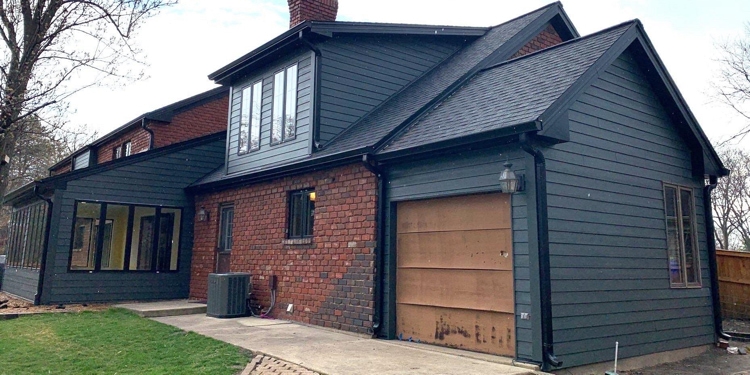
The good news is that asphalt and cedar provide some protection from embers, especially those from a manufacturer known for their quality and commitment to excellence in constructing top-notch products. Be sure to inquire with your roofing contractor about how they source their materials and make sure they can offer some fire resistance assurances.
Fireproof quality of cedar shingles and shakes
The caveat with cedar and fire prevention is that when you choose cedar as your roofing material, it needs to be treated with fire retardant prior to being installed. There are three levels of retardants used in today’s roofing industry ranging from Class A to Class C. Most homes are built in residential areas where the risk of a fire starting on the roof is quite minimal, so the Class C retardant is the most appropriate option.
Class C retardant will ensure that your roof is not “readily flammable.” At VIS Exterior, we source our cedar roofing products from manufacturers who will properly treat their cedar with the appropriate retardant to ensure that fire risks are minimized.
Fireproof quality of asphalt shingles
Among the more common roofing materials in use today across the U.S., asphalt is among the more fire resistant. In areas where fire risk is high (near forests or arid areas prone to wildfires), cedar roofs are against code, which means asphalt becomes an obvious choice over premium materials, such as terra cotta, slate or any other noncombustible material that is extremely expensive.
Obviously, asphalt shingles will have no bearing on fires originating from inside the home, but for homeowners who want that added layer of protection against fires that rarely originate from the roof, asphalt is the go-to option.
If you have questions about the fire resistant nature of roofing materials, reach out to VIS Exterior and we can walk you through all the different options.
How wind resistant are wood and asphalt shingle roofs?
The upper Midwest region is no stranger to high winds. And while prolonged hurricane-force gales are not something homeowners worry about, furious thunderstorms and tornadic activity are valid concerns. The question is, how will your roof material resist these short but powerful outbreaks of wind?

Wind resistance of cedar shingle & shake roof
For homeowners looking for a high degree of assurity that their roof will come out relatively unscathed year after year of stormy weather, cedar is the option they choose. In fact, cedar is among the more wind-resistant materials, handling gusts of up to 200-plus miles per hour.
When installed correctly, your cedar shingles should perform perfectly, even when massive thunderstorms rip through your area. When trees and surrounding foliage show major damage following a storm, it is not uncommon for cedar roofs in the neighborhood to show no signs of damage.
While a cedar roof or any type of roof can’t withstand the type of abnormal tornadic winds that send automobiles through the air, rest assured that under normal severe weather, your cedar roof is among the most wind resistant on the market today.
Wind resistance of asphalt shingle roof
Simply put, asphalt can’t compete with cedar where wind resistance is concerned. The kind of winds that test cedar will most assuredly damage, if not completely lift, asphalt shingles. This isn’t to say that asphalt shingles aren’t durable, because they can withstand some high winds. But should a gale-force even occur in your area, there is cause for having your roof inspected, as there could be damage that needs to be repaired immediately.
In most cases where high wind is present, the bigger danger is flying debris. When the debris, be it rocks, pieces of trees or foliage, impacts your asphalt shingles, they can erode the fine granules that protect the outer layer of your shingle, which will make your roof more vulnerable to extensive damage. The debris can also leave dents in your roof, which will reduce its ability to keep moisture out.
When properly installed, asphalt shingles can protect your home, yet even with the best installation, the shingles are no match for Mother Nature’s fury. At VIS Exterior, we provide thorough inspection services, so when a storm comes through your area, we will look for damages, make repairs and offer advice on whether or not a replacement is in order. Furthermore, we’ll communicate with your insurance agent so they get the pertinent information to get your claim through.
Cedar & asphalt shingle roofing options: products, colors and styles
Given the number of years the average homeowner resides in a house, they have just one chance at choosing the right roofing material, the right color and style. If you need assistance getting the right material and style for your home, VIS Exterior is here to help.
Cedar shingle & shake roofing options: Red or white cedar?
Cedar shingles and shakes are made from two different tree species – red and white. The red cedar comes from the Pacific Northwest, mainly Oregon, Washington and British Columbia. Even within the same tree the colors can range from a deep brown to a yellowish color. The cherished heartwood area of the tree is highly prized and renowned for its red color. Also called the western cedar, this wood is known for straight grain and its resistance to decay.
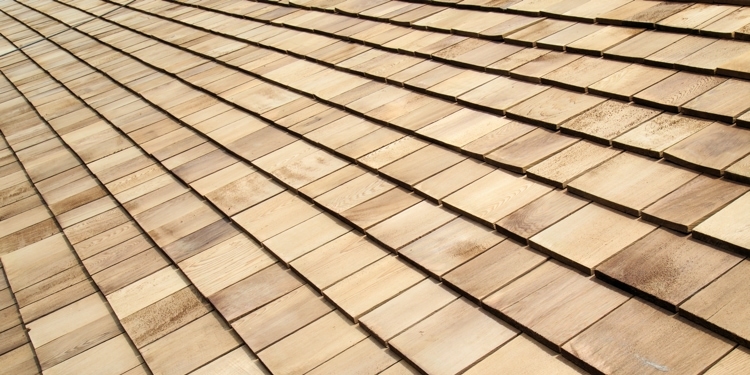
White cedar, also known as the eastern white cedar, is sourced from the northeastern U.S. and up into eastern Canada. It’s a much smaller tree than its western counterpart and has a fine wood texture. While the outer layers are a light color, sometimes dipping into yellow hues, the inner wood is more similar to the red cedar, with a pale brown appearance.
At VIS Exterior, we will work with our clients to determine which product will work best on their homes.
Asphalt shingle roofing: 3-tab or architectural?
There are two main styles of asphalt shingles: 3-tab shingle and architectural style asphalt shingles. While 3-tab shingles have been the most popular for decades, architectural style shingles are growing on homeowners. So, what’s the difference?
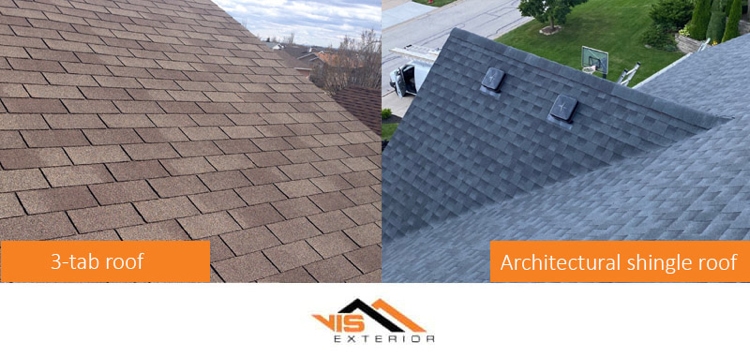
3-tab shingles are the most affordable. They get their name because they have three individual cutouts or tabs, each one foot long. This budget-friendly option offers solid performance and consistency, as each shingle is the same size, shape and thickness. Depending on the manufacturer, these shingles are made with an underlying fiberglass layer or a layer of recycled paper.
Architectural shingles, also called dimensional shingles, have a distinctive appearance that offer a more sophisticated feel. Rather than being cut with consistent tabs, these shingles are produced with varying thicknesses and widths, offering a more “architectural” or 3-D look.
At VIS Exterior, we know each of our clients have their own unique tastes, which is why we source our asphalt shingles, either 3-tab or architectural, from the best manufacturers that offer warranties on their products.
Cedar roof cost vs. asphalt shingle roof installation cost
After a roof reaches its 20th year on a home, most homeowners begin to think about replacing it. Obviously, one of the first questions that comes to mind is “what will a new roof cost?” The answer will depend on many things, including the materials you use, the size of the roof and the complexity of the job.
Will your old roof need to be torn off and disposed of? Because that will add to the cost. You might hear that an asphalt roof costs on average around $8,500 and a cedar roof around $16,500 on average. While those averages are correct and can give you an idea of what you’re getting into, keep in mind that your project could cost more or maybe even less than the average.
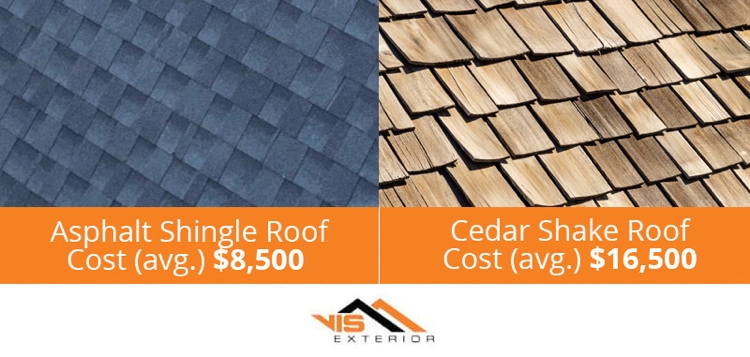
How much does a cedar roof cost to replace?
Most homes in the Chicago area have a roof that will require 20 squares of roofing material to cover. Each square is equal to 100 square feet. If you’re looking into cedar, you’ve likely figured out by now that it is a premium material that looks great, has wonderful insulating properties, but 20 squares of cedar likely cost you $18,000, labor included.
Yes, the price is quite a bit more than what you’ll pay for asphalt, but cedar lasts longer. Also, a cedar roof can add more value to your home than an asphalt roof will. There is no denying the beauty that cedar brings to a home, so for some homeowners the aesthetics alone are worth the cost. It’s important to bring in a quality roofer that knows how to work with cedar, otherwise you won’t get the value you had hoped for.
When you choose VIS Exterior, you’re getting a contractor with years of experience installing cedar roofs. We can also help you maintain your roof so you get all the life possible out of it.
How much does asphalt shingle roof cost to replace?
Among the budget-friendly roofing systems, asphalt shingles rank number one. Most roofing projects in the Chicago area where asphalt shingles are used will cost between $7,000 and $10,000. The gap in price is almost always related to the size of the home, but complexity and prep work can also add to the labor costs.
Manufacturers can produce three tab shingles at a lower cost, so they’re going to be less pricey than other popular shingle types, including architectural shingles, which are larger and have a more dimensional look. You can expect to pay between $1.50 and $2.50 per square foot of three tab shingles, but architectural shingles run between $2.25 and $3 per square foot.
When you consider the value of asphalt shingles you have to take into account how long they will last. Three tab shingles are rated to last between 20 and 25 years. Architectural (dimensional) shingles can last 30-plus years. In the best situation where weather never dramatically impacts a home with architectural shingles, they can last up to 50 years.
As with any home improvement project, you have to consider how much labor will cost. Working with a top-notch contractor that charges competitive fees for their expert services, you can expect to pay between $2 and $3 per square foot in labor alone. A roof with a pitch steeper than 4.5 degrees is considered difficult to work on, requiring more precautions and prep before a roofer can safely begin work, which will add to the labor fee. You also have to consider obstacles on the roof that have to be worked around, such as skylights and chimneys. The more obstacles, the higher the labor fees.
How to clean and maintain cedar & asphalt shingle roofing?
To get the most out of your roof, whether it’s asphalt or cedar, having it inspected annually by a roofing professional can help catch minor issues now that would otherwise turn into major issues later. While most asphalt roofs take less maintenance than cedar, every situation is different and it is recommended to consult with your roofing contractor about potential issues you might have with your roof. It is also recommended to work in an annual cleaning of your roof to ensure algae, mold and mildew never have a chance to do damage.
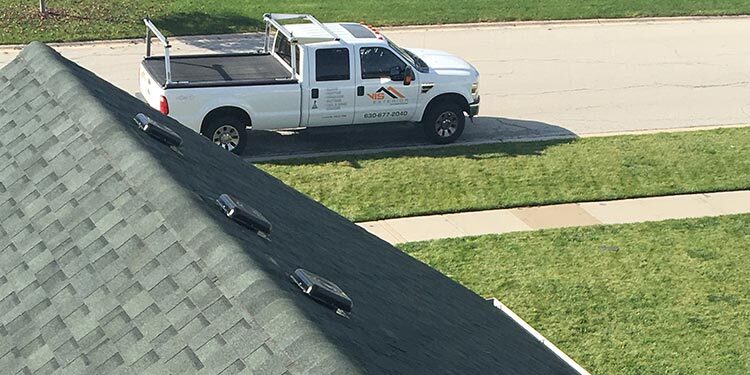
Tips for maintaining cedar roofing
One of the biggest “enemies” of cedar include nearby trees that hover over the top of the roof. This can lead to too much shade, which means moisture has a tougher time evaporating and can lead to rot. Nearby trees will also deposit debris, such as pine cones, leaves and branches. Furthermore, hovering trees can lead to the introduction of pests, including insects that will make a home in the cedar.
At VIS Exterior, we recommend removing branches that hover over a cedar roof or could potentially grow in that direction. This might require anything from some light trimming to complete removal of a tree or trees. As a rule of thumb, we recommend keeping all trees at least six feet from the roof.
We make sure our cedar is properly treated before we install it, which can vastly extend the life of the material. We also recommend to our customers that the roof system be inspected twice a year. This includes the cedar, flashing, gutters and all other parts of the system. This will alert the roofing professionals to potential issues that can be remedied, usually quite easily, allowing you to get many more years of life out of your roof.
Tips for maintaining asphalt shingle roofing
Just as you don’t want trees hovering over your cedar roof, the same can be said of asphalt. You don’t want mold or mildew taking root in your asphalt shingles, which is what can happen when you’ve got tree limbs nearby. The issue here is that the asphalt will absorb the moisture that isn’t allowed to evaporate because the tree is blocking sunlight. The absorption will lead to a buildup of moss, algae, mold and mildew that can compromise the integrity of the asphalt shingles.
If you notice a buildup of any organic growth, we recommend removing it with a mixture of water and chlorine, either applied with a soft bristle brush or via a low pressure spraying mechanism. This is an important step because organic growth can cause your shingles to curl, which means they’ll be more vulnerable to high winds. There is also the visual component – you don’t want patches of green taking hold, creating an eyesore.
Our recommendation at VIS Exterior is to have your asphalt roof inspected annually and cleaned of any debris or growth. During the inspection, we can take a close look at every component of the roofing system, including your gutters, ensuring that everything is in working order. This kind of dedication will yield results, most notably a roof that will last many, many years.
Roofing warranties and what they cover explained
When you’re narrowing down the list of roofing contractors, take a close look at their warranties and what they cover. At VIS Exterior, we offer a 10 year warranty on our roof installations. Our warranty covers all workmanship related to the installation of your roof products. The only caveat is that the warranty only covers the original homeowner that we contracted with. We also offer a 50-year manufacturer's defect warranty for general aniline and film (GAF) roofing system.
You should also know the differences between a manufacturer’s warranty and a workmanship or installation warranty. With a manufacturer’s warranty, you are covered should there be defects in the roofing material. Ask your contractor exactly what the manufacturer’s warranty will cover, because there are several components that go into a roofing system. Some manufacturers have stipulations about who can install their products, so make sure your contractor is certified, otherwise your warranty could be voided.
With a workmanship or installation warranty, you are covered should the contractor make mistakes during installation. While the best contractors rarely make mistakes, they will provide this coverage because it’s often a client demand. While many installation mistakes will make themselves evident in the first 12 months, it can take up to six years for some mistakes to lead to obvious flaws. For this reason, we offer a 10-year warranty on our installation services, giving plenty of time for the most elusive mistakes to be noticed while they are still under warranty.
Warranties for cedar shingle & shake
Manufacturers offer warranties on cedar shingle and shake that range from a low of 10 years to a maximum of 30 years. This gives homeowners coverage should the material be defective. Just as the warranty can vary in time per manufacturer, there are also variances in transferability of the warranty and cost recovery.
What will limit or void a manufacturer’s warranty is improper installation. Also, it’s not uncommon for the warranty to be voided when the product is installed by a contractor that has not been certified by the manufacturer as able to properly install the cedar.
Warranties for asphalt shingle
There are many options when you shop for asphalt shingles and there are also many different variations of warranties offered by manufacturers. The warranties most commonly associated with asphalt shingles are 25 to 30 years, but some manufacturers will offer a 50 year or “lifetime” warranty on their shingles.
It’s recommended to read the fine print before installing asphalt shingles, as some manufacturers will void the warranty if you choose a contractor that has not made it on their approved contractor list. At VIS Exterior, we have worked with a variety of shingle manufacturers and are authorized by every manufacturer that we buy from.
Cedar roof & asphalt shingle over metal roofing
At VIS Exterior, we get plenty of questions about roofing materials, and we are frequently asked about the advantages and disadvantages of metal as a roofing material. There are actually many roofing materials that are in use today including slate tiles and ceramic tiles, but metal roofing seems to be gaining in popularity, mostly because of its lifespan, which presents a “one and done” scenario for homeowners who only want to take on a roofing project once in their lifetime.
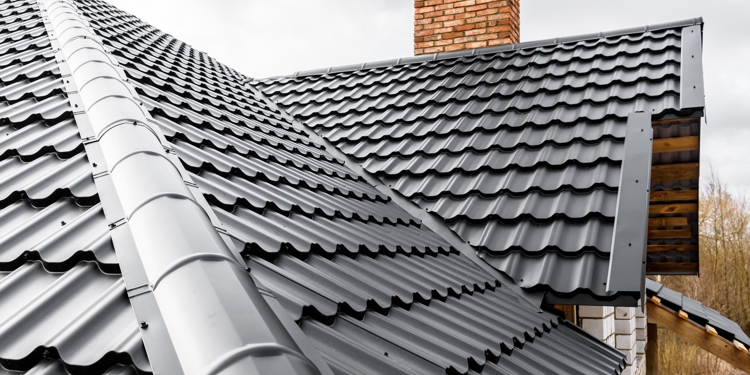
If a metal roof is installed without a protective gap, the heat from the sun will transfer directly into attic, causing increased utility costs, which only adds to the total cost of the already expensive roofing material option. If your contractor doesn’t know how to work with metal roofing or if your structure is a bad fit for it, you’re going to be at a disadvantage.
For a closer look at the difference between metal roofing material, cedar and asphalt shingles, let’s go over the pros and cons of metal roofing:
Metal roof pros:
- Long life – lasting around 40 to 70 years
- Comes in 100-plus colors and is stylish
- Fire resistant
- Low weight
Metal roof cons:
- Costing upwards of $900 per square, metal is not for the budget-minded
- Large hail, tree branches and other debris will dent metal
- The noise level is a concern during a rainshower
- Metal expands and contracts depending on the temperature, which means it must be expertly installed
- Difficult to color match should a section need to be repaired/replaced
- Low grade metal will rust, can be damaged by moisture and dent easily
At VIS Exterior, we recommend that our customers in the Chicago area choose asphalt or cedar shingles over metal roofing material. There is a reason cedar and asphalt have remained favorite material choices for decade after decade throughout the United States – these are materials that have proven their value to homeowners, time and again. Even if the metal roof fad seems to be gaining steam, asphalt and cedar shingles are simply timeless and are a better option for almost every residential property owner.
Cedar roof vs. asphalt shingle: which is better?
Simply put, there is not going to be a winner in this debate because there are too many variables that will make one product more preferable to the other. What might be a perfect scenario for one property owner to install cedar can differ wildly for another property owner’s unique situation. In some situations where upfront costs are an issue, the “better” option is going to be asphalt shingles for that reason alone.
For a property owner enthralled with the natural wood look that cedar offers and if they have the budget for it, cedar will be the “better” material. At VIS Exterior we work closely with our customers and assist them in making the right choice, keeping them informed about all the pros and cons of each so they can be confident in their final decision.
Choosing the experienced roof replacement contractor for the job
Since 2005, we’ve installed asphalt and cedar roofs on hundreds of homes. We’ve worked with all types of materials, installing them on all types of homes, which is why we’re considered the go-to expert for inspecting, installing, repairing and maintaining roofs in Chicagoland.
Our customers gain huge advantages when they hire VIS Exterior for a roofing project. We’re committed to safety, use the latest tools and techniques, hire only experienced roofers and we are licensed, certified and insured. If you’ve got questions, contact us and let’s discuss your project.
